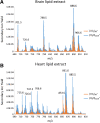(CO2)n+, (H2O)n+, and (H2O)n+ (CO2) gas cluster ion beam secondary ion mass spectrometry: analysis of lipid extracts, cells, and Alzheimer's model mouse brain tissue
- PMID: 33974088
- PMCID: PMC8222020
- DOI: 10.1007/s00216-021-03372-x
(CO2)n+, (H2O)n+, and (H2O)n+ (CO2) gas cluster ion beam secondary ion mass spectrometry: analysis of lipid extracts, cells, and Alzheimer's model mouse brain tissue
Abstract
This work assesses the potential of new water cluster-based ion beams for improving the capabilities of secondary ion mass spectrometry (SIMS) for in situ lipidomics. The effect of water clusters was compared to carbon dioxide clusters, along with the effect of using pure water clusters compared to mixed water and carbon dioxide clusters. A signal increase was found when using pure water clusters. However, when analyzing cells, a more substantial signal increase was found in positive ion mode when the water clusters also contained carbon dioxide, suggesting that additional reactions are in play. The effects of using a water primary ion beam on a more complex sample were investigated by analyzing brain tissue from an Alzheimer's disease transgenic mouse model. The results indicate that the ToF-SIMS results are approaching those from MALDI as ToF-SIMS was able to image lyso-phosphocholine (LPC) lipids, a lipid class that for a long time has eluded detection during SIMS analyses. Gangliosides, sulfatides, and cholesterol were also imaged.
Keywords: Alzheimer’s; Imaging; Lipids; Mass spectrometry; SIMS; Water clusters.
Conflict of interest statement
The authors declare no competing interests.
Figures





Similar articles
-
Intact lipid imaging of mouse brain samples: MALDI, nanoparticle-laser desorption ionization, and 40 keV argon cluster secondary ion mass spectrometry.Anal Bioanal Chem. 2016 Sep;408(24):6857-68. doi: 10.1007/s00216-016-9812-5. Epub 2016 Aug 22. Anal Bioanal Chem. 2016. PMID: 27549796 Free PMC article.
-
Exploiting the Semidestructive Nature of Gas Cluster Ion Beam Time-of-Flight Secondary Ion Mass Spectrometry Imaging for Simultaneous Localization and Confident Lipid Annotations.Anal Chem. 2019 Dec 3;91(23):15073-15080. doi: 10.1021/acs.analchem.9b03763. Epub 2019 Nov 11. Anal Chem. 2019. PMID: 31659904 Free PMC article.
-
Imaging of amyloid-β in Alzheimer's disease transgenic mouse brains with ToF-SIMS using immunoliposomes.Biointerphases. 2016 Jun 22;11(2):02A312. doi: 10.1116/1.4940215. Biointerphases. 2016. PMID: 26801213
-
Surface analysis of lipids by mass spectrometry: more than just imaging.Prog Lipid Res. 2013 Oct;52(4):329-53. doi: 10.1016/j.plipres.2013.04.005. Epub 2013 Apr 24. Prog Lipid Res. 2013. PMID: 23623802 Review.
-
Mass spectrometry imaging: Towards a lipid microscope?Biochimie. 2011 Jan;93(1):113-9. doi: 10.1016/j.biochi.2010.05.013. Epub 2010 Jun 4. Biochimie. 2011. PMID: 20570708 Review.
Cited by
-
Applications of spatially resolved omics in the field of endocrine tumors.Front Endocrinol (Lausanne). 2023 Jan 10;13:993081. doi: 10.3389/fendo.2022.993081. eCollection 2022. Front Endocrinol (Lausanne). 2023. PMID: 36704039 Free PMC article. Review.
-
Reactive Gas Cluster Ion Beams for Enhanced Drug Analysis by Secondary Ion Mass Spectrometry.Anal Chem. 2024 Sep 13;96(38):15185-93. doi: 10.1021/acs.analchem.4c02144. Online ahead of print. Anal Chem. 2024. PMID: 39270000 Free PMC article.
-
Recent Analytical Methodologies in Lipid Analysis.Int J Mol Sci. 2024 Feb 13;25(4):2249. doi: 10.3390/ijms25042249. Int J Mol Sci. 2024. PMID: 38396926 Free PMC article. Review.
-
Mapping the Molecular Landscape of Human DLBCL by GCIB-SIMS.Anal Chem. 2025 Apr 8;97(13):7186-7194. doi: 10.1021/acs.analchem.4c06594. Epub 2025 Mar 26. Anal Chem. 2025. PMID: 40139954 Free PMC article.
-
Advancements in ToF-SIMS imaging for life sciences.Front Chem. 2023 Aug 24;11:1237408. doi: 10.3389/fchem.2023.1237408. eCollection 2023. Front Chem. 2023. PMID: 37693171 Free PMC article. Review.
References
-
- Dowsett D, Wirtz T. Co-registered in situ secondary electron and mass spectral imaging on the helium ion microscope demonstrated using lithium titanate and magnesium oxide nanoparticles. Anal Chem. 2017;89(17):8957–8965. - PubMed
-
- Vickerman JC. Molecular imaging and depth profiling by mass spectrometry-SIMS, MALDI or DESI? Analyst. 2011;136(11):2199–2217. - PubMed
-
- Caprioli RM, Farmer TB, Gile J. Molecular imaging of biological samples: localization of peptides and proteins using MALDI-TOF MS. Anal Chem. 1997;69(23):4751–4760. - PubMed
-
- Takats Z, Wiseman JM, Gologan B, Cooks RG. Mass spectrometry sampling under ambient conditions with desorption electrospray ionization. Science. 2004;306(5695):471–473. - PubMed
MeSH terms
Substances
Grants and funding
LinkOut - more resources
Full Text Sources
Other Literature Sources
Medical

